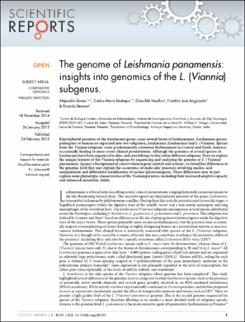| dc.contributor.author | Llanes, Alejandro | |
| dc.contributor.author | Restrepo, Carlos Mario | |
| dc.contributor.author | Del Vecchio, Gina | |
| dc.contributor.author | Anguizola, Franklin Jose´ | |
| dc.contributor.author | Lleonart, Ricardo | |
| dc.date.accessioned | 2020-06-17T02:59:38Z | |
| dc.date.available | 2020-06-17T02:59:38Z | |
| dc.date.issued | 2015-02-24 | |
| dc.identifier.other | DOI: 10.1038/srep08550 | |
| dc.identifier.uri | http://repositorio-indicasat.org.pa/handle/123456789/81 | |
| dc.description | Kinetoplastid parasites of the Leishmania genus cause several forms of leishmaniasis. Leishmania species pathogenic to human are separated into two subgenera, Leishmania (Leishmania) and L. (Viannia). Species from the Viannia subgenus cause predominantly cutaneous leishmaniasis in Central and South America, occasionally leading to more severe clinical presentations. Although the genomes of several species of Leishmania have been sequenced to date, only one belongs to this rather different subgenus. Here we explore the unique features of the Viannia subgenus by sequencing and analyzing the genome of L. (Viannia) panamensis. Against a background of conservation in gene content and synteny, we found key differences at the genomic level that may explain the occurrence of molecular processes involving nucleic acid manipulation and differential modification of surface glycoconjugates. These differences may in part explain some phenotypic characteristics of the Viannia parasites, including their increased adaptive capacity and enhanced metastatic ability. | en_US |
| dc.description.abstract | Kinetoplastid parasites of the Leishmania genus cause several forms of leishmaniasis. Leishmania species pathogenic to human are separated into two subgenera, Leishmania (Leishmania) and L. (Viannia). Species from the Viannia subgenus cause predominantly cutaneous leishmaniasis in Central and South America, occasionally leading to more severe clinical presentations. Although the genomes of several species of Leishmania have been sequenced to date, only one belongs to this rather different subgenus. Here we explore the unique features of the Viannia subgenus by sequencing and analyzing the genome of L. (Viannia) panamensis. Against a background of conservation in gene content and synteny, we found key differences at the genomic level that may explain the occurrence of molecular processes involving nucleic acid manipulation and differential modification of surface glycoconjugates. These differences may in part explain some phenotypic characteristics of the Viannia parasites, including their increased adaptive capacity and enhanced metastatic ability. | en_US |
| dc.format | application/pdf | |
| dc.language.iso | eng | en_US |
| dc.rights | Info:eu-repo/semantics/openAccess | |
| dc.rights | https://creativecommons.org/licenses/by/4.0/ | |
| dc.subject | The genome | en_US |
| dc.subject | Leishmania panamensis | en_US |
| dc.subject | insights into genomics | en_US |
| dc.title | The genome of Leishmania panamensis: insights into genomics of the L. (Viannia) subgenus. | en_US |
| dc.type | info:eu-repo/semantics/article | en_US |
| dc.type | Info:eu-repo/semantics/publishedversion | |

